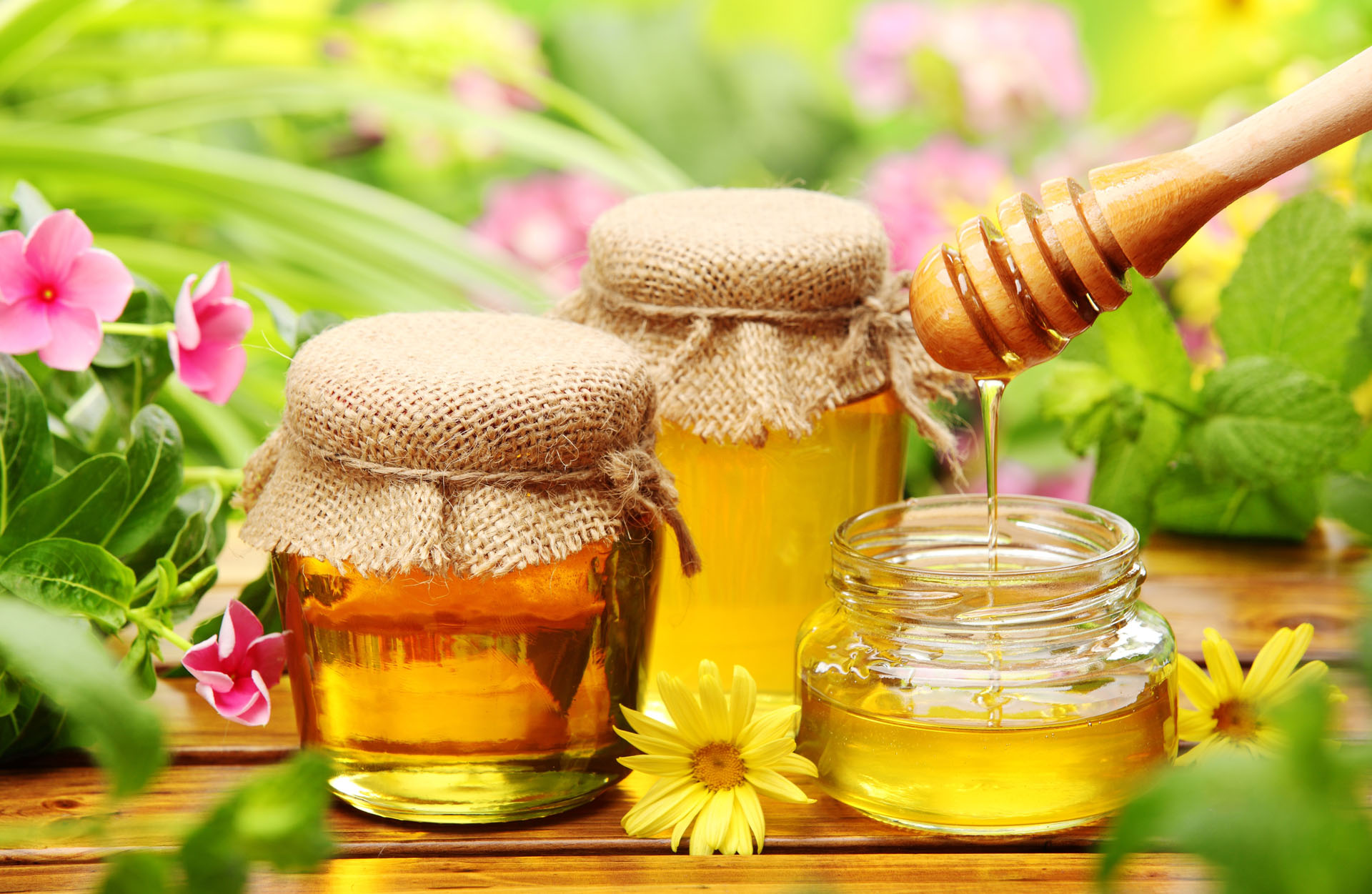Honey is a sweet and viscous fluid produced by bees from the nectar of flowers. The bees collect it, transform it, combine it with their own substances and store it in the honeycombs where it matures.
Characteristics and classification
The physical, chemical and organoleptic characteristics (taste, texture, smell and appearance) of honey are determined by the type of nectar that bees collect. The botanical origin of honey also defines how easy or difficult it is to crystallize.
According to its vegetable origin, we can classify honey:
- Miel de flores: la producida por las abejas a partir del néctar de las flores. Se distinguen muchas variedades:
- Monofloral: predominance of the nectar of one species of flowering plant. The most common are chestnut, rosemary, ulmo, thyme, heather, orange tree o orange blossom, linden, acacia, eucalyptus, lavender, blackberry, alfalfa, etcetera.
- Multifloral (Many flowers): from the nectar of several different plant species and in highly variable proportions
- From the mountain range or high mountains and desert (sweet stem, mesquite tree, gatun), which are special types of thousand flower honey.
- Honey flow or nectar flow, honey dew or forest honey: is produced by bees from the sweet secretions of aphid grape flea beetles, scale insects and other sap-sucking insects, usually of pine trees, firs, oaks, cork oaks and other shrubby plants. Usually less sweet, very dark, it solidifies with difficulty and it is not unusual to have a spicy and resinous smell and flavour. Honeydew honey from pines has a peculiar flavour of pine and is highly valued for its medicinal use in Europe and Turkey
The flower honey is transparent and is solidified over time depending on its region of provenance and temperature. Below 14°C the solidification process is accelerated. Depending on the variety of honeys, they harden quickly or take a long time to crystallize.
The study of pollen in virgin honey (melissopalynology) allows us to determine its floral origin. Since pollen particles are electrostatically charged and they attract other particles, the techniques used in the melissopalynology can be used in environmental studies of radioactive particles, powder or contamination
A side effect of the collection of nectar and pollen for the production of honey is the pollination, which is crucial for the reproduction of flowering plants. Moisture is a key component for the conservation of honey. While the humidity percentage remains below 18% nothing will grow on it. Above that value, fermentation processes may appear.
The mineral content is very small. The most common are calcium, copper, iron, magnesium, manganese, zinc, phosphorus and potassium. They are also present about half of the existing amino acids, organic acids (acetic acid, citric acid, among others) and vitamins of B complex, vitamins C, D and E. Honey has also a considerable variety of antioxidants (flavonoids and phenolic acids).
Uses
in Restaurants
Honey is mainly used in cooking and baking, as accompaniment of bread or toasts (especially, in breakfasts and snacks) and as an additive to various beverages such as tea. Being rich in sugars such as fructose, honey is hygroscopic (absorbs moisture from the air), so by adding a small amount of honey to breads and cakes makes them harden more slowly. Virgin raw honey also contains enzymes that help its digestion, as well as various vitamins and antioxidants. Therefore the consumption of honey at temperatures not above 60°C is usually recommended because at higher temperatures it begins to lose beneficial properties, since some of these elements are volatilized.
Vegetarians avoid taking honey, because technically it is a product of animal origin; not for the api-vegetarians who do eat honey anyway.
Therapeutic uses
L
Honey has many therapeutic properties (Havsteen 2002). It can be externally used due to its antimicrobial and antiseptic properties. Thus, honey helps heal and prevent infection in wounds or superficial burns. It is also used in cosmetics (creams, facial cleansing masks, toners, etc.) due to its astringent and soothing qualities.
Honey is also used in traditional medicine. It is an excellent natural preservative. However, it is not always healthy. Since it comes from wild flowers, there are some times and some places where the honey produced there by bees is highly toxic. The rhododendrons and azaleas produce a highly poisonous to humans nectar, although harmless to bees, which then produce a deadly honey. In some regions of the world, the hives are emptied immediately after the season of flowering, removing any residue to prevent accidental poisonings. There are stories of poisonous use of honey, as a weapon of war in the antiquity, but can not be corroborated. Such poisonous honey is very hard to find.
The shape of the azalea flower makes it difficult for the honeybees to access the nectar. In the time period when they bloom, there are almost always other flowers more attractive to bees.
Due to its content of simple sugars, of rapid assimilation, honey is highly caloric (about 3.4 Kcal/g), which is useful as an energy source. Honey is not spoiled, it is highly durable and does not expire. Thanks to its high concentration of sugar, it kills bacteria by osmotic lysis (cytolysis). The airborne yeasts can not thrive in honey because of the low moisture content. Shipments of human bodies in ancient times were dipped in honey, for example Alexander the Great was moved from Babylon to Alexandria in Egypt in 323 a. C. and that of Agesilaus II, king of Sparta, from Egypt to his home town, in 360 a. C., using honey to prevent decomposition. The preservative effect of honey is due to its low concentration of water and is identical to that required for the continued conservation of candy and fruit in syrup, where the sugary water content diminishes.
Bees also add an enzyme called glucose oxidase. When honey is applied on the wounds this enzyme produces the local release of hydrogen peroxide.
Precautions
 Honey (like other sweeteners) can also be extremely dangerous for babies. This is because when mixed with non-acidic digestive juices of the child, it creates an ideal environment for the growth of Clostridium botulinum spores, which produce toxins. Botulism spores are among the few bacteria that survive in honey, but are also widely present in the environment. Although these spores are harmless to adults, due to the heartburn creation, the digestive system of young children is not developed enough to destroy them, so that the spores could potentially cause infant botulism. For this reason, it is advisable not to feed them honey, or any other sweetener to children under the age of 12 months
Honey (like other sweeteners) can also be extremely dangerous for babies. This is because when mixed with non-acidic digestive juices of the child, it creates an ideal environment for the growth of Clostridium botulinum spores, which produce toxins. Botulism spores are among the few bacteria that survive in honey, but are also widely present in the environment. Although these spores are harmless to adults, due to the heartburn creation, the digestive system of young children is not developed enough to destroy them, so that the spores could potentially cause infant botulism. For this reason, it is advisable not to feed them honey, or any other sweetener to children under the age of 12 months

